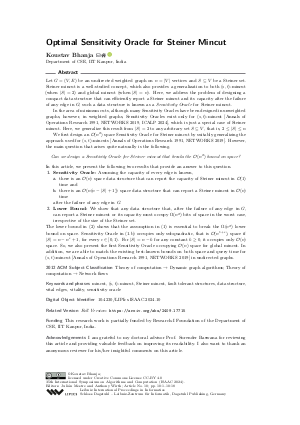LIPIcs.ISAAC.2024.10.pdf
- Filesize: 2.12 MB
- 18 pages

 Creative Commons Attribution 4.0 International license
Creative Commons Attribution 4.0 International license

Let G = (V,E) be an undirected weighted graph on n = |V| vertices and S ⊆ V be a Steiner set. Steiner mincut is a well-studied concept, which also provides a generalization to both (s,t)-mincut (when |S| = 2) and global mincut (when |S| = n). Here, we address the problem of designing a compact data structure that can efficiently report a Steiner mincut and its capacity after the failure of any edge in G; such a data structure is known as a Sensitivity Oracle for Steiner mincut.
In the area of minimum cuts, although many Sensitivity Oracles have been designed in unweighted graphs, however, in weighted graphs, Sensitivity Oracles exist only for (s,t)-mincut [Annals of Operations Research 1991, NETWORKS 2019, ICALP 2024], which is just a special case of Steiner mincut. Here, we generalize this result from |S| = 2 to any arbitrary set S ⊆ V, that is, 2 ≤ |S| ≤ n.
We first design an {O}(n²) space Sensitivity Oracle for Steiner mincut by suitably generalizing the approach used for (s,t)-mincuts [Annals of Operations Research 1991, NETWORKS 2019]. However, the main question that arises quite naturally is the following.
Can we design a Sensitivity Oracle for Steiner mincut that breaks the {O}(n²) bound on space?
In this article, we present the following two results that provide an answer to this question.
1. Sensitivity Oracle: Assuming the capacity of every edge is known,
a) there is an O(n) space data structure that can report the capacity of Steiner mincut in O(1) time and
b) there is an O(n(n-|S|+1)) space data structure that can report a Steiner mincut in O(n) time after the failure of any edge in G.
2. Lower Bound: We show that any data structure that, after the failure of any edge in G, can report a Steiner mincut or its capacity must occupy Ω(n²) bits of space in the worst case, irrespective of the size of the Steiner set.
The lower bound in (2) shows that the assumption in (1) is essential to break the Ω(n²) lower bound on space. Sensitivity Oracle in (1.b) occupies only subquadratic, that is O(n^{1+ε}), space if |S| = n-n^ε+1, for every ε ∈ [0,1). For |S| = n-k for any constant k ≥ 0, it occupies only O(n) space. So, we also present the first Sensitivity Oracle occupying O(n) space for global mincut. In addition, we are able to match the existing best-known bounds on both space and query time for (s,t)-mincut [Annals of Operations Research 1991, NETWORKS 2019] in undirected graphs.






Feedback for Dagstuhl Publishing